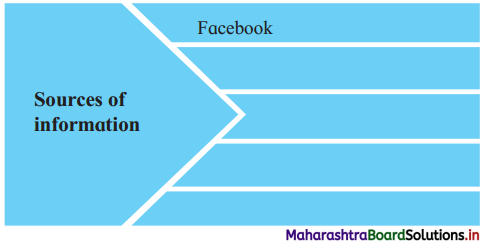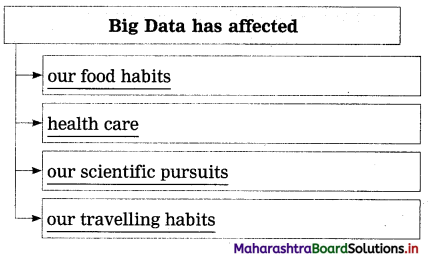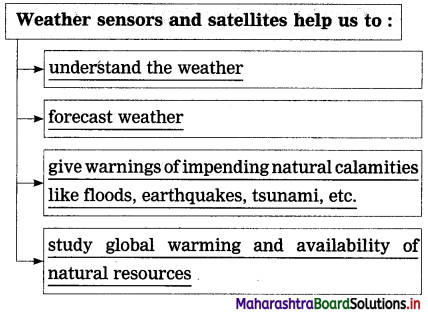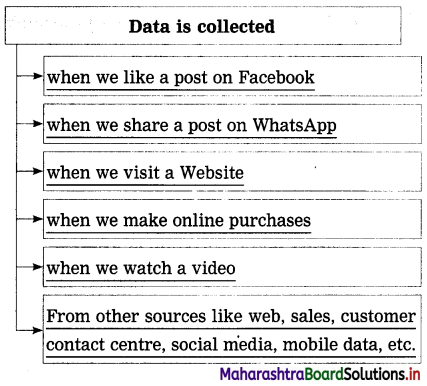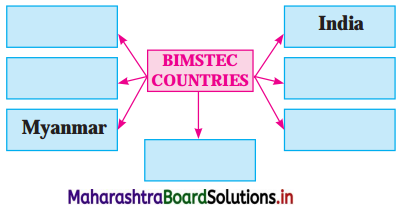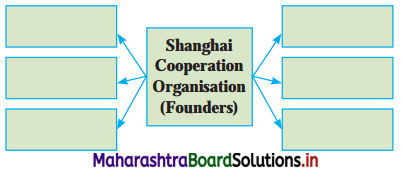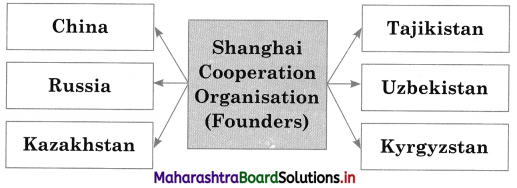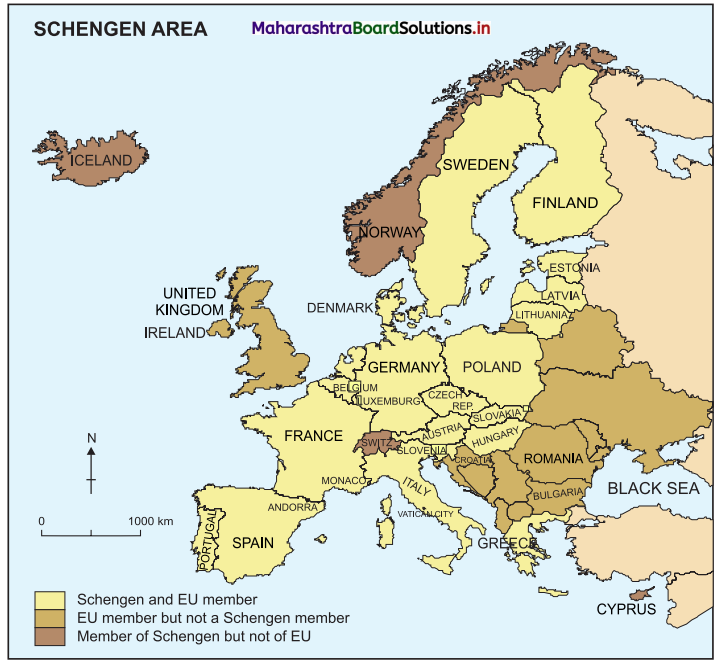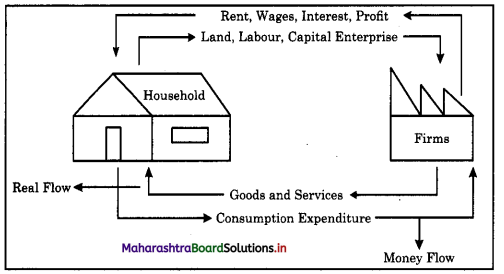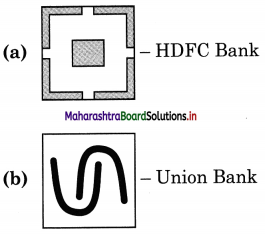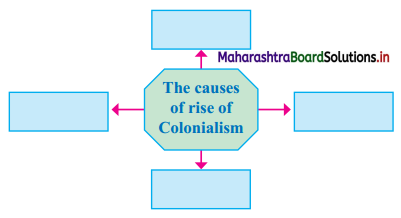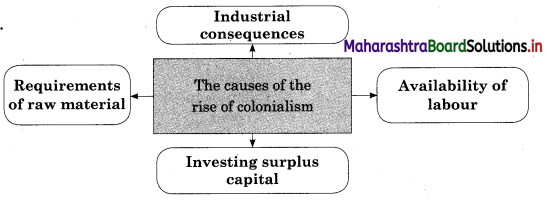Balbharti Maharashtra State Board Class 12 History Solutions Chapter 1 Renaissance in Europe and Development of Science Textbook Exercise Questions and Answers.
Maharashtra State Board Class 12 History Solutions Chapter 1 Renaissance in Europe and Development of Science
1A. Choose the correct alternative and rewrite the statement.
Question 1.
In 1440 ________ started the printing press.
(a) James Watt
(b) Gutenberg
(c) Aristotle
(d) Homer
Answer:
(b) Gutenberg
Question 2.
In 1609 _______ made a modified telescope.
(a) John Kay
(b) Copernicus
(c) Galileo
(d) Kepler
Answer:
(c) Galileo
![]()
Question 3.
_________ was the first explorer to circumnavigate the African continent.
(a) Henry the Navigator
(b) Marco Polo
(c) Bartholomew Dias
(d) Columbus
Answer:
(c) Bartholomew Dias
B. Find the incorrect pair from group ‘B’ and write the corrected one.
Question 1.
| Group ‘A’ | Group ‘B’ |
| (a) John Kay | Flying shuttle |
| (b) Samuel Crompton | Cotton gin |
| (c) Edmund Cartwright | Power loom |
| (d) James Watt | Steam engine |
Answer:
Samuel Crompton – Spinning Mule
2. Write the names of historical places/persons/events.
Question 1.
Father of the empirical science —
Answer:
Galileo
Question 2.
Scientists who told the world that the centre of our planetary system is the ‘Sun’ and not the ‘Earth’ —
Answer:
Nicolaus Copernicus
Question 3.
The treatise was written by Varahmihir —
Answer:
Brihatsamhita
![]()
3. Complete the following concept map.
Question 1.
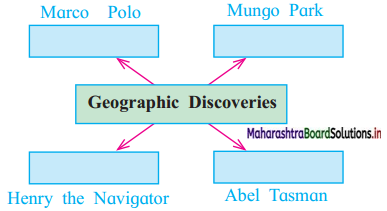
Answer:
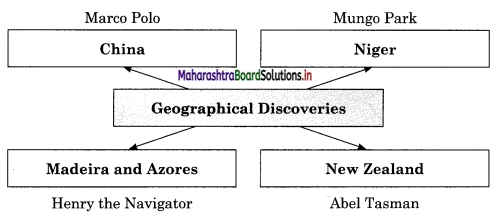
4. Write short notes.
Question 1.
European Crusades.
Answer:
- The two cities of Jerusalem and Bethlehem considered holy by the Jews, Christians, and Muslims were under Islamic rule in the 11th century.
- Christians of Europe wanted to regain hold over these cities and fought several wars known as ‘Crusaders’.
- The common people in Europe were highly inspired to be part of such religious wars.
- When the Pope announced that the sins of those who took part in such wars would be forgiven and would immediately go to Heaven, there was spontaneous participation by the common people in the crusaders.
- Besides social and political circumstances, the Roman emperors were also trying to bring Syria and Asia Minor under their control.
- Moreover, the rich merchants in Genova and Venice in Italy were looking for Central Asian markets to establish their trade.
- The first crusade started in 1096 C.E.
- A second call for the crusade was given by Pope Eugenius III who sought help from the French King Louis VII and the German King Conrad III.
- The crusaders were ultimately defeated by the Turks and in 1187 C.E. Saladin, the Sultan of Egypt defeated the crusaders by conquering Jerusalem.
- However, the crusaders failed for several reasons such as the attitude of the Pope and the European rulers common people losing faith, the rift between the Pope and the European kings, etc.
![]()
Question 2.
Metallurgy in Europe.
Answer:
- England had a number of iron mines.
- Therefore, it was necessary to advance the technique of smelting iron to acquire purified iron from it.
- The fuel for iron furnaces was replaced from wood to coal.
- Special machines were made to keep the furnaces at a set temperature and to maintain their aeration.
- In 1865, the process of producing steel from molten iron was invented and the nature of the iron industry underwent a major transformation.
- At about the same time, a method was adopted to pour the molten metal into casts for making iron bars (e.g. rails).
5. Explain the following statements with reasons.
Question 1.
The European Renaissance is supposed to have reached its zenith in the 15th-16th centuries.
Answer:
- The European Renaissance began in the 14th century C.E.
- It reached its zenith in the 15th and 16th centuries.
- These three centuries laid the foundations of a culture based on rationalism and science.
- This age gave a new direction to human intellect genius and way of life.
- People started writing poetry, drama, and fiction.
- Novel experiments were conducted in the field of science.
- In the pre-renaissance period, the thought about the existence of the universe revolved around ‘God’.
- In short, in this period new inventions, machinery, art, drama, literature, and geographical discoveries have taken place.
Question 2.
The ‘Industrial Revolution first began in England.
Answer:
‘Industrial Revolution’ indicates the transition from manual production to mechanized production.
- In England, the atmosphere was suitable for the industrial revolution.
- Large amounts of iron ore and coal were available.
- The humid climate of England was suitable for producing yarn.
- These conditions proved to be favourable for the textile industry in England.
- England had also established a large number of colonies by then so England could obtain raw material at cheap rates from these colonies.
- England could also export the processed goods and sell it in their colonies with large profit margins using their navy.
- The availability of cheap labour made it possible for them to maintain an optimum level of costs.
- These factors prepared the ground for the industrial revolution in England thus giving a boost to its economy. Because of the above reasons Industrial revolution first began in England.
![]()
6. State your opinion.
Question 1.
The European natural scientists of the 17th century laid the foundations of modern science.
Answer:
The scientists of the 17th century emphasized the following things:
- To prove that scientific principles established by empirical experiments are true despite time and space.
- To convert the emergent scientific rules into scientific formulae.
- To create new scientific parlance and so on.
These efforts helped the progress of science.
Question 2.
The economy based on surplus production supported economic nationalism and also imperialism.
Answer:
- Economic nationalism began the vicious circle of continuously capturing new marketplaces, searching for sources of a cheap supply of raw material, maintaining an unbroken chain supply of raw material), to attract more and more investors, to safeguard their investments. This resulted in limitless exploitation of the colonies.
- Extreme nationalism, industrialization, concepts of racial superiority, aggressive colonial policies further supported the growth of imperialism.
- The result was the immense expanse of the empires like England, France, Belgium, Germany, etc.
7. Answer the following questions in detail.
Question 1.
Explain the causes and effects of European crusades.
Answer:
Causes of European crusades:
- The two cities of Jerusalem and Bethlehem considered holy by the Jews, Christians, and Muslims were under Islamic rule in the 11th century.
- Christians of Europe wanted to regain hold over these cities and fought several wars known as ‘Crusaders’.
- The common people in Europe were highly inspired to be part of such religious wars.
- When the Pope announced that the sins of those who took part in such wars would be forgiven and would immediately go to Heaven, there was spontaneous participation by the common people in the crusaders.
- Besides social and political circumstances, the Roman emperors were also trying to bring Syria and Asia Minor under their control.
- Moreover, the rich merchants in Genova and Venice in Italy were looking for Central Asian markets to establish their trade.
- The first crusade started in 1096 C.E.
- A second call for the crusade was given by Pope Eugenius III who sought help from the French King Louis VII and the German King Conrad III.
- The crusaders were ultimately defeated by the Turks and in 1187 C.E. Saladin, the Sultan of Egypt defeated the crusaders by conquering Jerusalem.
- However, the crusaders failed for several reasons such as the attitude of the Pope and the European rulers common people losing faith, the rift between the Pope and the European kings, etc.
The crusades had far-reaching effects:
- According to some historians, the crusades led to the end of feudalism in Europe.
- The faith in the Pope began to decline.
- The contact with the regions in Central Asia led to the increased trade and new venues were opened for cities in Italy and Germany.
- It led to the rise of a new class of traders.
- European warfare went through many changes for e.g. they acquired expertise in building forts, managing the forts as military outposts, building bridges, etc.
- The European kings levied new taxes which were added to the royal treasury.
- The Europeans were introduced to newer types of plants, fruits, perfumes, etc.
- The Europeans came in contact with the Arabs and adopted many Arabic words in Alchemy, Music, and Commerce.
Question 2.
Give detailed information on the development of science and scientific inventions during the renaissance period.
Answer:
The scientists of the 17th century emphasized the following things:
- To prove that scientific principles established by empirical experiments are true despite time and space.
- To convert the emergent scientific rules into scientific formulae.
- To create new scientific parlance and so on.
- These efforts helped the progress of science.
- The compass, the barometer, telescope, and the thermometer were invented during this period.
- Microscopes were invented to observe various types of micro-organisms.
- Robert Boyle, an alchemist discovered that that the absolute pressure and the volume of a gas are inversely proportional.
- The research in physics was more focused on heat and sound.
- In zoology, a methodology known as ‘Taxonomy’ was developed to classify animals.
- Benjamin Franklin’s research was on lightning and electricity. He coined many technical terms which are used in science even today.
Class 12 History Chapter 1 Renaissance in Europe and Development of Science Intext Questions and Answers
Try to do this. (Textbook Page No. 3)
Collect information about how the early European universities worked.
Answer:
- Early European universities were the University of Bologna in 1088 or the University of Paris (1150-1170).
- the University of Bologna is considered the ‘mother of universities’.
- European universities concentrated on science and research
- Original Medieval universities arose from the Roman Catholic Church schools
- Purposes included training of professionals, scientific investigation, and teaching critical thinking and research.
- During Renaissance, the humanist ideas were slowly accepted
- Universities began preparing the student for a civilized life
- The curriculum included liberal arts such as Trivium (grammar, rhetoric, logic) and Quadrivium (arithmetic, geometry, astronomy, music)
Find it out. (Textbook Page No. 8)
Make a list of the European countries where the Industrial Revolution spread in its first stage.
Answer:
The industrial revolution first began in Britain in the late 1770s and first spread to Belgium followed by France and the German states and in North America.
![]()
Project (Textbook Page No. 9)
Collect detailed information about the voyages of Bartholomew Dias and Vasco-da- Gama and read it aloud in the class.
Answer:
(A) Bartholomew Dias:
- Bartholomew Dias was a Portuguese explorer.
- He was the first European to sail around the southern tip of Africa which the Portuguese would name as the ‘Cape of Good Hope.
- Dias and his crew departed from Lisbon, Portugal in August 1487 with three ships.
- Dias’s expedition sailed along the African coast following the route of Diogo Cao who had earlier sailed along the African coast in the 1480s.
- Near the southern tip of Africa Dias’s 3 ships sailed into a dangerous storm that pushed them away from the African coast. They sailed around the tip of Africa in January 1488 without seeing the land.
- After 30 days without seeing land, he entered what he named Aguada de Sao Bras (Bay of Saint Blaise) in February 1488.
- Dias wanted to continue to India but he was forced to turn back when his crew refused to go further and the rest of the officers favored going back home.
- It was on his return journey that he actually discovered the Cape of Good Hope in May 1488.
- Dias returned to Lisbon in December 1488 after an absence of 16 months and 17 days.
(B) Vasco da Gama:
- Vasco da Gama was a Portuguese explorer and the first European to reach India by sea.
- His initial voyage to India was the first to link Europe and Asia by an ocean route, connecting the Atlantic and Indian Oceans and therefore the West and the Orient.
- This discovery is considered to be a milestone in world history.
- Vasco da Gama’s discovery of the sea route to India opened the way for an age of imperialism in Asia.
- Vasco da Gama landed in Calicut, India on May 20, 1498.
- This boosted the economy of the Portuguese Empire.
- Vasco da Gama led the two of the India Armadas, the first and the fourth.
- In 1524, Vasco da Gama was appointed as Governor of India, with the title of Viceroy, and was ennobled as Count of Vidigueria in 1519.
